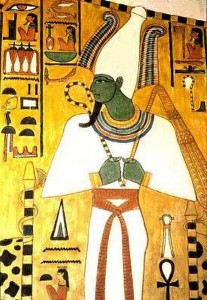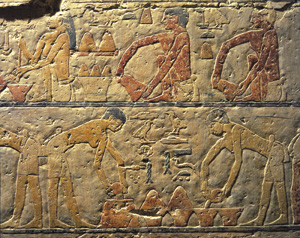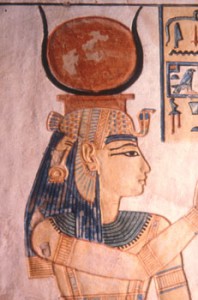
Sumerian depiction of two people partaking of KAŠ (beer) via reed straws. The beer was held within a clay vessel. Beer was consumed largely in a social way throughout history.
History, Culture, and Why You Should Drink Craft Beer – Part 2
My goal as a writer, and lover, of craft beer is two-fold. I want to express my adoration for the craft and the product in such a way that it sparks reader’s curiosities and emboldens them to go forth and embrace their own love for craft beer. Secondly, I mean to educate readers in the deep interplay beer (and fermented beverages in general) has played throughout our entire existence. Beer is important, and it has bolstered our species by being part of a means to survive and thrive, as a part of culture and community, and as a damn good beverage if done right. This brings me to the topic of this post, history of beer and how it has related to us.
Sumer
The earliest known evidence for the knowledge of beer production casts us back to 8000 – 6000 BCE, with variance due to location. This predates what most would call the start of civilization, with the advent of writing systems and intensive agricultural practices circa 4000 BCE and the start of the Bronze Age. This time frame will bring us alongside two important ancient cultures in association with beer and brewing: Sumer and Egypt. Sumer came into existence around 3400 BCE as a cluster of ethnically and linguistically linked city-states, and persisted until 2300 BCE, when they were absorbed into the Akkadian Empire.
Sumer was geographically local to the first region of Earth to have undergone domestication of cereal grains, and this advantage led to Sumer having the honor of being the first brewing country to exist. Some of the earliest records found for Sumer are accounts for stores of, and uses for, barley and emmer (early wheat) exclusively for brewing. As such, the entirety of the Sumerian population, through all eras of its existence, partook of Sumerian beer.
Beer, or KAŠ, was tied into much of daily life and culture of Sumer, as a reflection of the importance of the substance to the people. Evidence reveals that for temple workers, part of the daily chores to be accomplished were the preparation of brewing ingredients. Barely was also rationed out to laborers, who would then brew beer on their own. Beer was also used as compensation for work.
Sumer had many different types of beer; standard barely beers, mixed beers, spiced beers, and long aged beers. In general, beers were broken down into categories of quality, ingredients, methods of processing, color and taste – these were used to then identify the beers in daily Sumerian life. Strict accounts of the Sumerian process for beer brewing are practically non-existent, as are recipes. This seems to stem from the fact that much of the process and technological knowledge was passed on by oral means, and much of the written records deal mostly with ingredient issues than process issues.
What is known is that “beer loaves”, or “BAPPIR”, were used along with water, earthen vessels, sieves, and strainers. BAPPIR are either small malt loaves created from crushed malt being turned into a dough and twice baked, or as a combination of malt products that as a whole were called BAPPIR. The former seems to be the most popularly held contention, though. During the brewing process, it appears that date juice, honey or grapes and raisins could be added as a source of additional sweetness. In fact, date beer may have been a specialty brewed in Sumer due to evidence of specialized vessels used exclusively for date beer.
Yeast was not directly pitched in these cases, as the vessels themselves contained micro flora that were most likely a mix of yeast and other microbes that would accomplish and affect fermentation. There are examples of both filtered and unfiltered beers being made in Sumer. As a result of these unfiltered beers, straws were a common accessory for the beer drinker in Sumer. Recovered artifacts depict scenes of multiple individuals drinking beer from the vessels via straws, which lends support to the idea that imbibing beer was a social activity to some degree. While usually made from reeds, there have been very elaborate and ornate straws recovered from a royal tomb at the site of Ur, one of the Sumerian city-states. Over time, it seems that BAPPIR fell out of favor, and dates became more of the primary source of sugars in Sumerian beer.
Within Sumer were tavern like establishments, that may have also served as brothels. These taverns were most often run by females, and the beer was made on premises by these female proprietars. The taverns that also served as brothels were only run by women, which is important to note as during the Code of Hammurabi years all liquor laws were concerned with women transgressors (here the concern supposedly being more criminal elements consorted in these tavern brothels). These establishments were more frequented by the lower classes within Sumerian society, as social drinking for the upper class was found more at banquets. These banquets were held due to religious rituals, military achievements, funerals and so forth, and were much more subdued affairs over that of the atmospheres of the taverns.
Beer was also thought of as a fertility and arousal agent, and there are depictions of use of beer during the act of intercourse. There appears to be a relation between beer, women, and sexual practices in Sumer according to recovered records that show repeated images of women in sensual ways along with the presence and use of beer.
Ninkasi was the goddess of brewing for the Sumerian culture. She is “the Lady who fills the mouth” and the “Lady of the inebriating fruit”. She is the only female deity in Sumer that is the representative of a profession. She is also the mother of nine children, all of whom were named according to some aspect of beer. Perhaps this mythological fertility is where the cultural relation of women, beer, and sex comes from. One of the recovered artifacts of the Sumerian culture is the “Hymn to Ninkasi“. This “hymn” is in actuality a set of directions on how to brew a beer, according to the technology of the day in Sumer.
Egypt
Evidence suggests that production of beer, and beer having a deep connection with the length and breadth of Egyptian existence, was full in effect around 5500 BCE, which was the Egyptian predynastic era. And let it be said that within Egypt, brewing was carried out on a massive, national scale. So much so, that Egypt was able to reliably export this product to other nations. Greek scholars, from the 1st century BCE, praised Egyptian beer, and attributed the creation of beer to the Greek god Dionysus. Ancient Egyptians would beg to differ, as their god Osiris is credited with the invention of beer.

The Egyptian god who created beer, Osiris.
Beer was a part of every day life for the entirety of Egypt’s inhabitants, as the beer brewed there was a potable liquid, which enabled a reliable source of hydration and nutrition. This is a theme that will be repeated throughout history and cultures, that of the safety in a potable beverage that beer affords human kind. The basic principles behind this are that the amount of alcohol in a fermented beverage, a beer like product, will kill any dangerous microorganisms deleterious to the health and safety of humans. In this role, there were beers brewed that were very small in ABV and would need to be consumed within a very short time span. This is not to say that more long term and stronger beers were not brewed, because they most certainly were, and had rather cool, heavy-handed names as well. “The Beer of Truth” sounds like something you would like to drink, right?
Beer was involved in day to day life, for simple nutrition and hydration, all the way to the highest offices and religious rites in the land. It was consumed as both a social and religious necessity. I mean, when one of your most important gods creates beer, you damn well drink it all the time. In fact, drinking beer carried religious associations, and a drunken state was considered an inspired spiritual state. Within more social contexts, banquet etiquette was such that if an attendee left in a sober state, it was seen as an affront to the hosts. There was, in fact, a day of drunkenness on the Egyptian calender known as “Th”. I suppose this was their St. Patrick’s day?
Grains were the rock from which the Egyptian economy was based upon, and food stores were built, from household stores all the way up to national storage facilities. Which works out for the saturation of beer within ancient Egyptian life and culture. It was also a very large reason why beer drinking far outweighed the simpler, less inspired, production of wine via crushing of grapes with their skins. Grains were a means of a reliable food stuff, via bread, and was easily grown and harvested. Cereal grain and beer were used as a form of payment for labor as well, much as was seen in Sumer.

Depiction of Egyptians going through the process of making beer.
Production was carried out via an initial malting and milling process to turn the grains into flour, and that flour half-baked into loaves, and used a process of placing these loaves into water and fermentation allowed to occur in large vats. This process bears strong resemblances to the Sumerian beer making practices. The process did not remain the same over time, and additions and changes to Egyptian brewing science occurred, as well as an increased care for and respect to yeast health for fermentation. In this manner, it has been proposed that reliance on amylase from malt itself transferred over to amylase derived from specialized mold sources used for fermentation (amylase breaks down starches into fermentable sugars here). There is great evidence for this being a primarily female performed process. Further it is believed that facilities that made beer were a combination bakery/brewery model of production, since the production of bread was similar to that of initial beer production.
Flavoring additions to Egyptian beer were made mostly with dates, while other sources were used to varying degrees, if at all. It is also thought that some of these bittering sources were simply partaken of at the same time as beer, instead of the beer being brewed with them. These bitter items were lupine, skirret, and plant roots, possibly radish.

Hathor, in her kinder form, the inventor of brewing for Egypt.
As said previously, there is great evidence of brewing being a female dominated role, which can be seen from the artistic records left by the ancient Egyptians. Much of the steps of beer production was regarded as a domestic activity, which seems to have been under the purview of women within Egypt. The deity credited with invention of the brewing process, Hathor, was also female. Whether this view precipitated the female heavy role, or an already female dominant role produced this view is unclear. Hathor was a widely worshiped deity within Egypt, as she was a representative of joy, love and motherhood. Associated alongside Hathor, was another minor goddess, Menqet, who was touted as the “goddess who makes beer”.
According to Egyptian mythology, Hathor, having taken on the avenging form of Sekhmet, was close to obliterating humanity for transgressions against the god Re. However, her assault upon humanity was so savage and bloody that Re took pity upon humanity, and brewed a red beer. Re then spread this beer out across the fields, and in doing so made it seem as so the surface of a mirror. Hathor/Sekhmet, upon seeing her reflection drew close to the beer to admire herself, and then proceeded to drink the beer. She then became drunk, so drunk in fact that she forgot her purpose of destroying humanity. As such, beer saved humanity, according to Egyptian mythology. This story highlights how important beer was in regards to Egyptian culture. It is interesting to highlight here the relationship of women to beer in light of this story – a rampaging female goddess is subdued with beer, which is associated heavily with women within Egypt as producers of beer. It is intriguing to view this as a depiction of cultural views regarding women, as it paints a very empowering picture, with both the power of violence and that of pacification. In the end though, it becomes fairly clear that at the very least, females and beer maintained a close relationship within Egypt.
Final Thoughts; or, What I Would Like for People to Take Away from All This
There are a few things that I feel need particular highlighting:
Beer has always been there since the beginning of civilization, and has sustained us.
Beer is not just simply malt, water, yeast and hops; beer was locally unique, and could be made with varied products to become a thing of infinite possibilities.
Beer was also not crystal clear, which is a ridiculous notion that has been perpetuated from the post prohibition era of mass production beer (read: Bud, Miller, Coors).
Beer can be “funky”, due to wild yeasts and other microorganisms. Thankfully, it is becoming easier to find examples of these wild fermentation styles, so if these interest you, there is a good chance you can quench that curiosity.
Beer is a tool to create and foster communities, and acts as a social nexus. It was used to celebrate achievement, and to mourn loss. As long as it is used well, and not abused, beer is a positive connecting force within society.
The final bit I really want to have an impact, is this: Beer is not a “man’s” drink. For much of human existence women have been far more intimately entwined with beer in all of it’s aspects than men. Major female deities were heavily associated with beer, and I feel that this was just a reflection of culture as mythology. In modern times, women have been marginalized, objectified, sexualized and pushed out of our beer culture for decades. It is an awful idea that we, as a culture, have perpetuated much to the detriment of ourselves as human beings, and as an industry. Beer does not care about your sex or gender. Beer is made for the enjoyment of everyone, regardless of social class, skin tone, or sex.
I hope that these things will foster and encourage people to go out and try some local craft beer. Ontario is blessed with some very amazing breweries, who do their damndest to make great beer that is something Ontario, and Canada, can be proud of. Support good craft beer!
Before I call it a day, the following beer is a modern day attempt at the ancient Egyptian styles, Ta Henket by Dogfish Head. I know there have been other attempts at these ancient style ales, but this is one that I know for a fact is more easily obtainable. If you are interested in seeing what beer could have been like thousands of years ago, this is a good idea of what it would be.
Cheers!
 Jared Lewinski is obsessed with beer. As such, he has uprooted his life in New Jersey to attend the Brewmastery and Brewery Operations Management program at Niagara College, a program that has, for the past three years, been producing top-tier brewers for Canada and beyond. As a child of the American Craft Movement, Jared has big opinions and a love for big beers. His hope is to bring an outsider’s perspective to a fascinating and tumultuous time for Canadian and Ontario made craft beer, and the culture that it represents…And I found this to be particularly amusing in my studies of Sumer.
Jared Lewinski is obsessed with beer. As such, he has uprooted his life in New Jersey to attend the Brewmastery and Brewery Operations Management program at Niagara College, a program that has, for the past three years, been producing top-tier brewers for Canada and beyond. As a child of the American Craft Movement, Jared has big opinions and a love for big beers. His hope is to bring an outsider’s perspective to a fascinating and tumultuous time for Canadian and Ontario made craft beer, and the culture that it represents…And I found this to be particularly amusing in my studies of Sumer.








Very interesting subject. Well done!